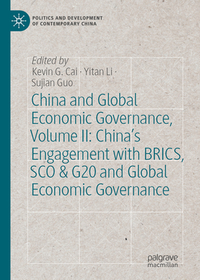
Strategic Navigation through Economic Corridors
Intersecting Geoeconomics and Geopolitics
Series: Europe-Asia Connectivity;
- Publisher's listprice EUR 128.39
-
53 249 Ft (50 714 Ft + 5% VAT)
The price is estimated because at the time of ordering we do not know what conversion rates will apply to HUF / product currency when the book arrives. In case HUF is weaker, the price increases slightly, in case HUF is stronger, the price goes lower slightly.
- Discount 12% (cc. 6 390 Ft off)
- Discounted price 46 860 Ft (44 628 Ft + 5% VAT)
Subcribe now and take benefit of a favourable price.
Subscribe
53 249 Ft

Availability
Not yet published.
Why don't you give exact delivery time?
Delivery time is estimated on our previous experiences. We give estimations only, because we order from outside Hungary, and the delivery time mainly depends on how quickly the publisher supplies the book. Faster or slower deliveries both happen, but we do our best to supply as quickly as possible.
Product details:
- Publisher Springer Nature Singapore
- Date of Publication 27 October 2025
- Number of Volumes 1 pieces, Book
- ISBN 9789819660100
- Binding Hardback
- No. of pages257 pages
- Size 210x148 mm
- Language English
- Illustrations XI, 257 p. 8 illus., 7 illus. in color. 700
Categories
Long description:
This book offers an in-depth investigation into the dynamic relationship that exists between geoeconomics and geopolitics in the context of contemporary economic corridors. It dives deep into the strategic significance of economic corridors, which are essential arteries of trade, investment, and connection across regions and nations. It examines how a variety of geopolitical issues have an impact on the creation, management, and exploitation of these corridors, hence influencing the dynamics of regional power and the tendencies of the global economy. The book takes a multidisciplinary approach to investigate the intricate relationships that exist between economic interests, political aspirations, and security concerns throughout significant economic corridors all over the world. It investigates how governments, multinational enterprises, and international organizations negotiate the complex environment of geoeconomic competitiveness and geopolitical conflicts to maximize their strategic advantages and minimize the risks. It is beneficial for policymakers, corporate executives, and academics who are interested in understanding and navigating the dynamic convergence of geoeconomics and geopolitics in the arena of economic corridors with practical insights.
More
Table of Contents:
"
Chapter 1: Strategic Navigation through Economic Corridors – Intersecting Geoeconomics and Geopolitics: An Introduction .- Part I: Economic Corridors and Global Governance.- Chapter 2: Transnational Economic Corridors. A New Form of Global Governance?.- Chapter 3: Transitology in Eurasia Institution Building, Transitional Justice in Times of New Global Order.- Chapter 4: The BRICS and Economic Corridors: Geoeconomic Convergences and Divergences.- Chapter 5: Role of the North-South Corridor on Iran’s convergence with the Shanghai Cooperation Organization members.- Part II: The BRI Vis -a-Vis the other Economic corridors: Geoeconomics Analysis .- Chapter 6: IMEC and the BRI: Complementary or Opposite Ways.- Chapter 7: China’s Belt and Road Initiative in South Asia’s Strategic Cultures: Differing Perceptions and Possibilities for Implementation.- Chapter 8: The Impact of War on Economic Corridors: BRI and Ukrainian War.- Part III: Economic Connectivity Amid Geopolitical Transitions.- Chapter 9: The Impact of the Gaza War on the Future of IMEEC.- Chapter 10: The Transformative Role of The Crisis: A Peaceful Approach to The Zangazur Corridor.- Chapter 11: INSTC And Central Asia: Unlocking Economic Potential Through Strategic Engagement.- Chapter 12: Bridging the Governance Gap: The Impact of Economic Corridors like INSTC on Trade and Institutional Disparities.
" More









